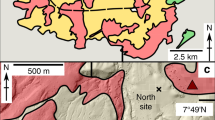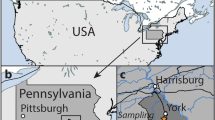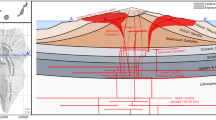Abstract
Conventionally1, three important characteristics of ignimbrites are that they show a very pronounced tendency to pond in topographic depressions, possess a flat, horizontal or gently sloping upper depositional surface, and have a thickness generally between 10 and 1,000 m. The youngest major ignimbrite, that of 1912 in the Valley of Ten Thousand Smokes (Alaska)2–4 shows these characteristics well, being ponded in a valley 25 km long with a flat upper surface sloping down-valley at an average of 1.3°, and having an estimated thickness exceeding 100 m in places. AU three characteristics are commonly used as field criteria to distinguish ignimbrites from other pyroclastic rock bodies. Here we look at certain ignimbrites which depart significantly from this conventional form in that a major part of them occurs as a thin layer mantling the landscape, resting on slopes as steep as 30°, and with an upper surface sensibly parallel with the underlying surface. We have studied two examples, the 1,800-yr-old5 Taupo ignimbrite (New Zealand), and the 1,400-yr-old Rabual ignimbrite (New Britain)6,7. We also cite several others. These ignimbrites have a remarkably low aspect ratio. This ratio, previously applied to lava extrusions8,9, provides a useful means of quantifying the overall geometry of rock bodies. The ratio is that of average thickness to lateral spread; conveniently the latter is taken as the diameter of the circle which covers the same area as the rock body.
This is a preview of subscription content, access via your institution
Access options
Subscribe to this journal
Receive 51 print issues and online access
$199.00 per year
only $3.90 per issue
Buy this article
- Purchase on Springer Link
- Instant access to full article PDF
Prices may be subject to local taxes which are calculated during checkout
Similar content being viewed by others
References
Smith, R. L. Bull. geol. Soc. Am. 71, 793 (1960).
Griggs, R. F. The Valley of Ten Thousand Smokes (National Geographical Society, Washington D. C., 1922).
Curtis, G. H. Geol. Soc. Am. Mem. 116, 153 (1968).
Sbar, M. L. & Matumoto, T. Bull. Volcan. 35, 335 (1972).
Healy, J., Vucetich, C. G. & Pullar, W. A. N.Z. geol. Surv. Bull. n.s. 73 (1964).
Heming, R. F. Contr. Miner. Petrol. 38, 1 (1973).
Heming, R. F. & Carmichael, I. S. E. Bull. Geol. Soc. Am. 85, 1253 (1974).
Walker, G. P. L. Phil. Trans. R. Soc. A274, 107 (1973).
Hulme, G. Geophys. J. R. astr. Soc. 39, 361 (1974).
Sparks, R. S. J. Sedimentology 23, 147 (1976).
Wilson, C. J. N. (in preparation).
Ui, T. Bull. Volcan. Soc. Japan 18, 153 (1973).
Self, S. 1976 J. geol. Soc. Lond. 132, 645 (1976).
Gibson, I. L. Contr. miner. Petrol. 28, 89 (1970).
Walker, G. P. L. Q. Jl. geol. Soc. Lond. 118, 275 (1962).
Waters, A. C. & Fisher, R. V. J. geophys. Res. 76, 5596 (1971).
Marshall, C. E. Trans. R. Soc. N.Z. 64, 1 (1935).
Sparks, R. S. J. & Wilson, L. J. geol. Soc. Lond. 132, 441 (1976).
Fenner, C. N. J. Geol. 33, 193 (1925).
Gilbert, C. M. Bull. Geol. Soc. Am. 49, 1829 (1938).
Walker, G. P. L. J. volcan. geotherm. Res. (in the press).
Author information
Authors and Affiliations
Rights and permissions
About this article
Cite this article
Walker, G., Heming, R. & Wilson, C. Low-aspect ratio ignimbrites. Nature 283, 286–287 (1980). https://doi.org/10.1038/283286a0
Received:
Accepted:
Issue Date:
DOI: https://doi.org/10.1038/283286a0
This article is cited by
-
Multiphase flow behaviour and hazard prediction of pyroclastic density currents
Nature Reviews Earth & Environment (2020)
-
Pulsating flow dynamics of sustained, forced pyroclastic density currents: insights from a facies analysis of the Campo de la Piedra Pómez ignimbrite, southern Puna, Argentina
Bulletin of Volcanology (2020)
-
Sedimentation and mobility of PDCs: a reappraisal of ignimbrites’ aspect ratio
Scientific Reports (2017)
-
A revised age of ad 667–699 for the latest major eruption at Rabaul
Bulletin of Volcanology (2015)
-
The ground layer of the Campanian Ignimbrite: an example of deposition from a dilute pyroclastic density current
Bulletin of Volcanology (2015)
Comments
By submitting a comment you agree to abide by our Terms and Community Guidelines. If you find something abusive or that does not comply with our terms or guidelines please flag it as inappropriate.



